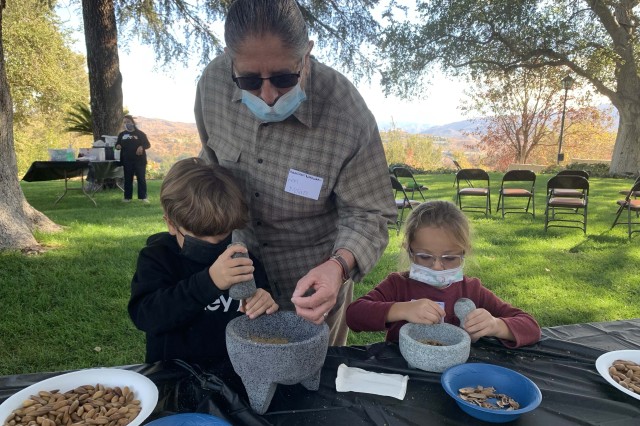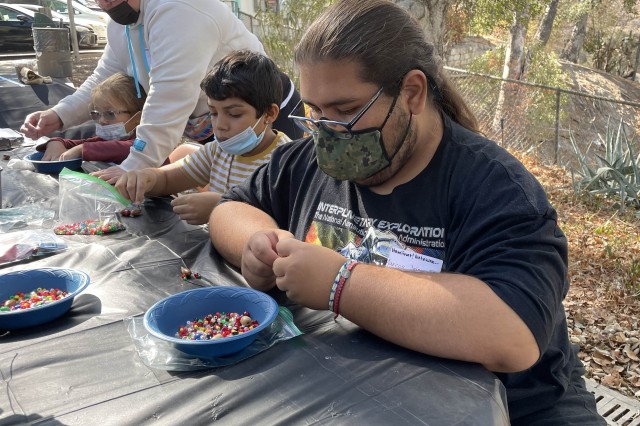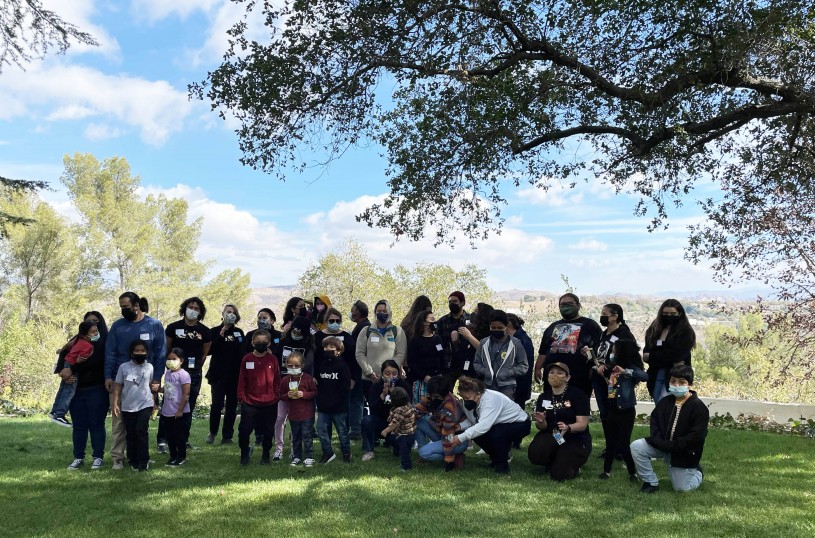Seeds of the Ancestors
Beneath the majestic limbs of the coast live oaks, an acorn harvest blooms at the William S. Hart Museum

Published November 8, 2022
The stately community of coast live oaks near the entrance to the William S. Hart Museum have been releasing seeds for centuries. One day not that long ago was unlike any other, though, because the many families who gathered under the canopy of evergreens to collect the acorns belong to local Native American tribes, the grove’s first harvesters.
The Fernandeño Tataviam Band of Mission Indians embrace the coast live oak (syutka in Tataviam) as kin; whenever the tribe’s ancestors were buried, their spirit became part of the soil that would enrich the tree for thousands of years. To celebrate this Southern California architectural marvel, and its life-giving bounty, the FTBMI’s Education and Cultural Learning Department partnered with the museum for a program, Traveling Tataveaveat: Acorn Harvest, on Saturday, November 5.
This is the second such program. Last year, more than 40 people, including parents and students, arrived from all the valleys—San Fernando, Simi, Santa Clarita, and Antelope. They fanned out under the gnarled limbs of the Quercus agrifolia to collect the acorns which would later be mashed, rinsed, leached, and pulverized into flour using traditional methods and tools.

The youngest children, clutching large plastic containers as big as their heads, hunted with intention. Joshua Agular, who is Acjachemen from the Orange County area, smiles as he trailed behind his scampering trio—seven-year-old Miles, five-year-old Amelie, and three-year-old Jeremiah. The kids scanned the blades of grass for the slender reddish-brown fruit called wihuc (Tataviam for acorn). This activity was an enjoyable way for his children to appreciate this Native American dietary staple. “I remember eating acorn cereal when I was little,” Agular said. “It’s important to bring indigenous foods in to the diet.”
Flour Power
With the seed-hunting portion of the day complete, the participants tipped what they’d collected into a tub of water for “the float test,” removing those that bobbed at the surface, a sign that burrowing insects had gotten to them first. The remainders stayed in the bath a bit longer so that the tannins/tannic acid, a bitter tasting substance, could leach out.

Elizabeth Daniels
The acorns are taking a bath. The ones that bob to the surface have holes in them, evidence that insects took a bite or two.

Jessica Portner
Joshua Agular, and his son, drop acorns in metal bins for a "float test" to weed out the buggy ones.
1 of 1
The acorns are taking a bath. The ones that bob to the surface have holes in them, evidence that insects took a bite or two.
Elizabeth Daniels
Joshua Agular, and his son, drop acorns in metal bins for a "float test" to weed out the buggy ones.
Jessica Portner
The traditional method of processing the acorns came next. Students and families gathered at long tables and got cracking. They smashed open the shells, peeled the skins, and pounded the insides using mortars and pestles. The pulverizing activity was a hit with both toddlers and teens.
Marcos Jaime, Jr. said crushing the acorns was his favorite part of the day. “It was fun to just go at it. You don’t need to hold back on anything.” The high school teenager, who gets his Tataviam heritage from his mom, is training to be a spiritual advisor with the tribe. He thought the program was a “very good thing to help people, especially the younger ones, learn about what we do, what we did do and what we will do.” Jaime added: “I want to see how my ancestors saw the world."

Milena Acosta
After cracking the shell and peeling the skin, it's time for the mortar and pestle, the traditional way to process acorns.

Jessica Portner
Using the stones to pulverizing the seeds into meal was a highlight of the day.

Milena Acosta
Marcos Jaime, Jr. was one of many participants who gathered at long tables under the oak tree to string drilled acorns and colorful beads into necklaces.

Elizabeth Daniels
The take home bags for all included dry ingredients to make acorn bread
1 of 1
After cracking the shell and peeling the skin, it's time for the mortar and pestle, the traditional way to process acorns.
Milena Acosta
Using the stones to pulverizing the seeds into meal was a highlight of the day.
Jessica Portner
Marcos Jaime, Jr. was one of many participants who gathered at long tables under the oak tree to string drilled acorns and colorful beads into necklaces.
Milena Acosta
The take home bags for all included dry ingredients to make acorn bread
Elizabeth Daniels
Ecology for the Ages
Jenée Ornelas, Program Director of the Education and Cultural Learning Department of the Fernandeño Tataviam Band of Mission Indians, who is also Tataviam, said that throughout the day they talked with people there about the ecology of Southern California and preservation of woodland habitats.
“We relayed information from our elders on the more traditional methods of caring for oak trees,” she said. The way Native Americans kept the ecosystem healthy for thousands of years was through controlled burns. Oak trees are adapted to survive a small or medium-sized fire; fire burns up dry or unhealthy plants, giving some healthy ones the space and light to grow larger.
“Our heritage as humans,” Ornelas said, “is to understand environmental maintenance and be caretakers of the land.” “I know that people were really happy that we had Hart Park as a resource to be able to gather so many acorns because of the preservation of the oaks onsite,” says Natasha Daniels, also of the ECLD. "We live in L.A., not everyone has an oak tree in their backyard!”
Baked-in Traditions
Settling in on the grass under the massive trees’ crescent-shaped crowns, Stephanie Rodriguez, said she was happy that both her children, 11-year-old Gabriel, and her toddler, Benjamin, were learning all the steps to make flour from seeds, the traditional way. “I do have native blood, but we are trying to figure out our full background,” she said. “We’re on a journey together as a family. I am first showing them the culture.” Before they went home, each family was given a baking kit that included dry ingredients to make acorn bread. “The kids loved it. We baked the loaf and it was actually really delicious,” said Rodriguez. “It’s very neat how everything was provided for the kids and the community. Everything worked out perfectly. It’s been a blessing.”

The Education and Cultural Learning Department of the Fernandeño Tataviam Band of Mission Indians' Traveling Tataveaveat program takes youth and families to various Tataviam village sites, one of which is the land that includes William S. Hart Museum and Park. FTBI is a community partner of NHMLAC. Learn more about upcoming their programs here.

